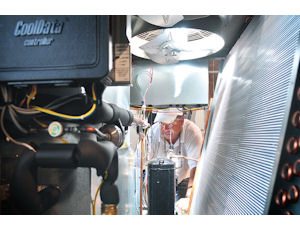Ice Energy has arrived in Glendale just in time for summer. The company finished relocating its headquarters to the Valley last month from Colorado, as Southern California has been ground zero for the firm’s burgeoning business. Its product — the Ice Bear — attaches to a commercial air conditioner, creates ice at night, and then stores the ice so the air conditioner can use the melt off to cool the building during the day. Utilities in Glendale and Burbank, as well as Southern California Edison have partnered with the company in a bid to reduce costs and energy use during peak hours. “Our system is an alternative to just building more and more traditional infrastructure, including power plants,” said Mike Hopkins, the company’s executive vice president for corporate development and legal. Ice Energy, which has raised more than $90 million since it was founded in 2003, sees the Southern California market as especially profitable. Hopkins said the regulatory environment and community opposition makes it more difficult to build new power plants and transmission lines. Plus, air conditioning use is widespread in the hot climate — giving the company a large potential client base, he said. “We are only scratching the surface,” Ice Energy CEO Dave Prezioso said. About 30 employees work at the new headquarters and national distribution center, located off San Fernando Road. Ice Energy says the Ice Bear reduces air conditioning energy demand during peak hours by as much as 95 percent, which is significant because air conditioning accounts for 40 to 50 percent of a building’s electricity use during those hours. But the company still faces challenges. The Ice Bear takes up significant space on a building, which limits its use on many large buildings in highly dense locations that often have high electricity costs, said analyst Aditya Ranade of Lux Research. “We think it is their Achilles Heel,” Ranade said. Hopkins said space limitations have not held the company back. And although there isn’t much competition in the ice storage realm, the Glendale firm must battle competing technologies — such as solar energy storage — that are also designed to decrease energy demand during peak hours, Ranade said. Despite those challenges, the company has landed significant deals in Southern California. It has signed an agreement with the Southern California Public Power Authority to install energy storage units for the authority’s members. Hopkins said the deal could eventually bring in $100 million. Of those members, Glendale has made the greatest commitment to using Ice Energy’s technology. In recent years, Glendale has added about 180 Ice Bear units for about $3.2 million, said Glenn Steiger, general manager for Glendale Water & Power. In the last year, the units have been installed at 28 Glendale city buildings and 58 businesses. Some, Steiger said, have even been installed at Disney’s Glendale campus. With the utility’s investment already saving money, Glendale Water & Power hopes to add about 1,000 more units in the next three years, Steiger said. He said the city council would be charged with deciding whether to approve the contract, estimated to be under $10 million. Those additional units could mean big savings. If all are installed, Steiger predicted Glendale’s Ice Bears could save as much as $40 million over the lifetime of the units. Because energy costs about five to 10 times as much during peak hours, shifting usage is a significant cost saver, he said. The units will also reduce the amount needed to invest in new infrastructure, he added. Since 2008, Burbank Water and Power has installed 34 Ice Bear units at city buildings and commercial businesses as part of a pilot project, said Jeanette Meyer, marketing manager for the city’s utility. Another pilot project is in the works. Most of Ice Energy’s projects have been pilots, but that is changing, especially since last summer, Hopkins said. “All of the contracts I am working on right now are large scale — they are not pilots,” he said. Southern California Edison has also teamed up with Ice Energy. The utility offers rebates to replace aging air conditioners with a new version coupled with an Ice Bear. The city of Palmdale has also expressed interest in using the Ice Bear, Prezioso said. Although the ice storage concept has been around for a long time, the products on the market today are of a higher quality than those of yesteryear and are available in different versions, so they can suit a variety of existing building types, said Haresh Kamath, program manager for energy storage at the Electric Power Research Institute. They also are less expensive to produce, he said. Ranade, the Lux Research analyst, said he’s bullish on Ice Energy’s future despite the noted challenges. The Ice Bear technology is an efficient and cost effective way to reduce peak energy use, he said. The company also has done an excellent job at locating its target market of smaller buildings, he added. “I think they may be one of the success stories in the storage area in the next three to four years,” Ranade said.
